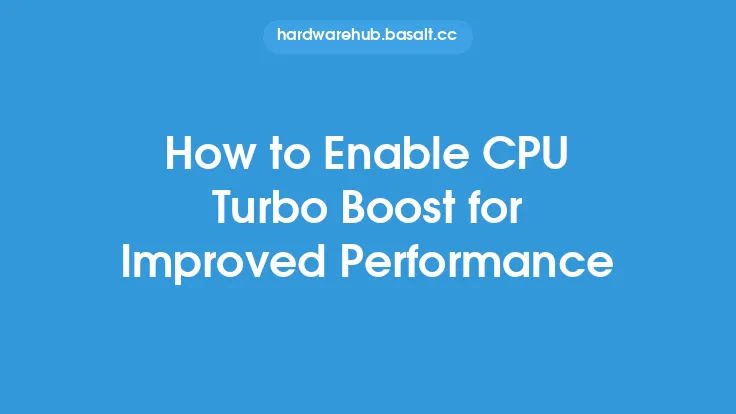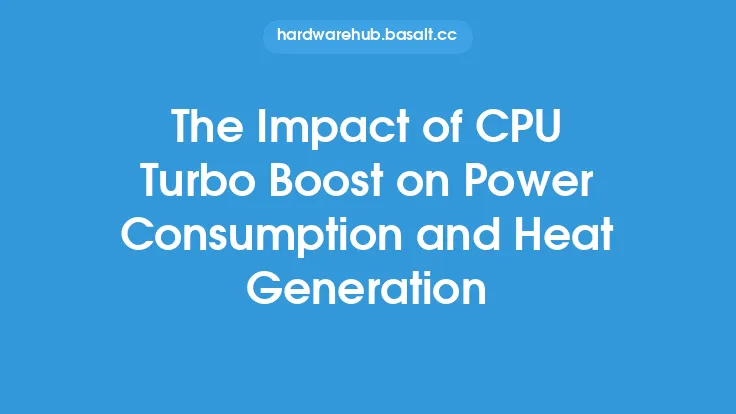To maximize CPU performance, it's essential to understand the intricacies of Turbo Boost, a technology that allows processors to temporarily increase their clock speed when needed. This feature is particularly useful for applications that require intense processing power, such as video editing, 3D modeling, and gaming. By leveraging Turbo Boost, users can unlock their CPU's full potential and achieve significant performance gains.
Introduction to Turbo Boost
Turbo Boost is a dynamic overclocking technology developed by Intel that enables processors to run at higher clock speeds than their base frequency. This is achieved by dynamically adjusting the CPU's voltage and frequency in real-time, based on the workload and available power headroom. When a CPU is operating below its maximum power limit (also known as the Thermal Design Power or TDP), Turbo Boost can increase the clock speed to take advantage of the available power budget. This results in improved performance, reduced processing times, and increased system responsiveness.
Understanding Turbo Boost Parameters
To maximize CPU performance with Turbo Boost, it's crucial to understand the key parameters that influence its operation. These include:
- Base clock speed: The default clock speed of the CPU, measured in GHz.
- Boost clock speed: The maximum clock speed that the CPU can reach when Turbo Boost is engaged.
- Power limit: The maximum power consumption of the CPU, measured in watts.
- Temperature limit: The maximum temperature at which the CPU can operate safely.
- Turbo duration: The length of time that the CPU can maintain its boost clock speed.
Optimizing System Configuration for Turbo Boost
To get the most out of Turbo Boost, users should optimize their system configuration to ensure that the CPU can operate efficiently. This includes:
- Adequate cooling: A high-quality cooling system is essential to prevent overheating, which can limit Turbo Boost's effectiveness.
- Sufficient power supply: A power supply unit (PSU) that can deliver the required power to the CPU is necessary to support Turbo Boost.
- Compatible motherboard: A motherboard that supports Turbo Boost and has the necessary power delivery components is essential.
- Efficient memory: Fast and efficient memory can help to minimize bottlenecks and allow the CPU to operate at its full potential.
Monitoring and Controlling Turbo Boost
To maximize CPU performance, users should monitor and control Turbo Boost to ensure that it's operating within safe limits. This can be achieved using various software tools, such as:
- Intel Extreme Tuning Utility (XTU): A software tool that allows users to monitor and adjust Turbo Boost parameters, including the boost clock speed and power limit.
- CPU-Z: A software tool that provides detailed information about the CPU, including its clock speed, voltage, and temperature.
- HWiNFO: A software tool that provides real-time monitoring of system components, including the CPU, memory, and power supply.
Best Practices for Maximizing Turbo Boost
To get the most out of Turbo Boost, users should follow best practices, such as:
- Updating drivers and firmware: Regularly updating drivers and firmware can help to ensure that the CPU is operating with the latest optimizations and bug fixes.
- Disabling unnecessary features: Disabling unnecessary features, such as hyper-threading or virtualization, can help to reduce power consumption and minimize bottlenecks.
- Using power-saving features: Using power-saving features, such as Intel's SpeedStep or AMD's Cool'n'Quiet, can help to reduce power consumption when the system is idle.
- Overclocking with caution: Overclocking the CPU can help to increase performance, but it should be done with caution to avoid damaging the CPU or reducing its lifespan.
Conclusion
Maximizing CPU performance with Turbo Boost requires a deep understanding of the technology and its parameters. By optimizing the system configuration, monitoring and controlling Turbo Boost, and following best practices, users can unlock their CPU's full potential and achieve significant performance gains. Whether you're a gamer, content creator, or simply a power user, Turbo Boost can help to take your system to the next level and provide a more responsive and productive computing experience.





